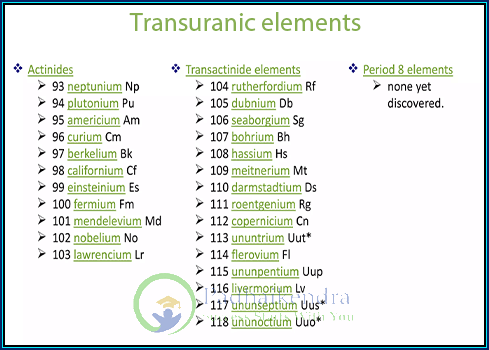What are Transuranic elements?
Transuranic elements are elements that have atomic numbers greater than that of uranium (92), which means they have more than 92 protons in their nucleus. All transuranic elements are synthetic, meaning they do not occur naturally on Earth and must be created in a laboratory by nuclear reactions.
The most well-known transuranic elements are:
- plutonium (Atomic Number- 94)
- americium (Atomic Number- 95)
- curium (Atomic Number- 96)
- berkelium (Atomic Number- 97)
- californium (Atomic Number- 98)
- einsteinium (Atomic Number- 99)
- fermium (Atomic Number- 100)
- mendelevium (Atomic Number- 101)
- nobelium (Atomic Number- 102)
- lawrencium (Atomic Number- 103)
- rutherfordium (Atomic Number- 104)
- dubnium (Atomic Number- 105)
- seaborgium (Atomic Number- 106)
- bohrium (Atomic Number- 107)
- hassium (Atomic Number- 108)
- meitnerium (Atomic Number- 109)
- darmstadtium (Atomic Number- 110)
- roentgenium (Atomic Number- 111)
- copernicium (Atomic Number- 112)
- nihonium (Atomic Number- 113)
- flerovium (Atomic Number- 114)
- moscovium (Atomic Number- 115)
- livermorium (Atomic Number- 116)
- tennessine (Atomic Number- 117)
- oganesson (Atomic Number- 118).
Transuranic elements are highly radioactive and have unstable nuclei, making them prone to radioactive decay. They typically have short half-lives, which means they decay relatively quickly. The synthesis and study of transuranic elements have contributed to our understanding of nuclear physics, the periodic table, and the behavior of heavy elements.
The production of transuranic elements is primarily achieved through nuclear reactions, such as neutron capture or particle bombardment.
These elements are typically produced in small quantities and are challenging to isolate and study due to their radioactivity and short half-lives.
Transuranic elements have various applications, particularly in nuclear research, nuclear power generation, and military applications. Plutonium, for example, is widely used in the production of nuclear weapons and as a fuel in nuclear reactors. Americium and curium have applications in smoke detectors and certain types of industrial gauges.
Due to their radioactivity and potential hazards, transuranic elements require careful handling and containment to minimize the risks associated with their radiation. The long-term storage and disposal of transuranic waste, including nuclear waste containing these elements, is an important consideration in nuclear waste management.
In short, transuranic elements are a group of synthetic elements with atomic numbers greater than uranium. They are highly radioactive and have unstable nuclei, and their synthesis and study have contributed to our understanding of nuclear physics. These elements have applications in nuclear research, power generation, and military technology, but they also present challenges in terms of handling and waste management due to their radioactivity.





